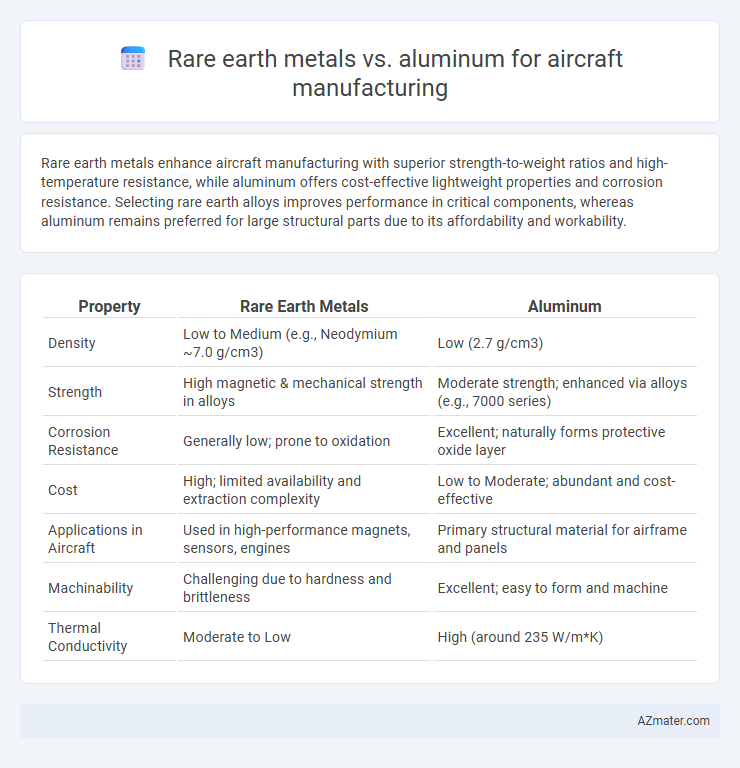Rare earth metals enhance aircraft manufacturing with superior strength-to-weight ratios and high-temperature resistance, while aluminum offers cost-effective lightweight properties and corrosion resistance. Selecting rare earth alloys improves performance in critical components, whereas aluminum remains preferred for large structural parts due to its affordability and workability.
Table of Comparison
| Property | Rare Earth Metals | Aluminum |
|---|---|---|
| Density | Low to Medium (e.g., Neodymium ~7.0 g/cm3) | Low (2.7 g/cm3) |
| Strength | High magnetic & mechanical strength in alloys | Moderate strength; enhanced via alloys (e.g., 7000 series) |
| Corrosion Resistance | Generally low; prone to oxidation | Excellent; naturally forms protective oxide layer |
| Cost | High; limited availability and extraction complexity | Low to Moderate; abundant and cost-effective |
| Applications in Aircraft | Used in high-performance magnets, sensors, engines | Primary structural material for airframe and panels |
| Machinability | Challenging due to hardness and brittleness | Excellent; easy to form and machine |
| Thermal Conductivity | Moderate to Low | High (around 235 W/m*K) |
Introduction: Rare Earth Metals vs Aluminum in Aircraft Manufacturing
Rare earth metals exhibit unique magnetic, electrical, and thermal properties that enhance aircraft performance through lighter weight and improved fuel efficiency compared to traditional aluminum alloys. Aluminum remains a staple in aircraft manufacturing due to its high strength-to-weight ratio, corrosion resistance, and cost-effectiveness. Advances in composite materials and rare earth metal alloys are driving innovation, offering potential improvements in durability and operational efficiency over conventional aluminum components.
Historical Use of Aluminum in Aerospace
Aluminum has been the cornerstone of aircraft manufacturing since the early 20th century, prized for its lightweight, high strength-to-weight ratio, and corrosion resistance. Rare earth metals, although offering superior magnetic and thermal properties, have historically been too costly and challenging to process for widespread aerospace use compared to aluminum alloys. The extensive development of aluminum-based materials and manufacturing techniques established it as the dominant metal in aerospace structures, powering advancements from World War II fighters to modern commercial jets.
Rise of Rare Earth Metals in Modern Aircraft
Rare earth metals play a crucial role in modern aircraft manufacturing due to their exceptional magnetic, catalytic, and heat-resistant properties, which outperform aluminum in key applications such as jet engines and lightweight structural components. The rise of rare earth metals like neodymium and dysprosium enhances fuel efficiency and reduces overall aircraft weight, contributing to lower emissions and improved performance. Increasing demand for advanced aerospace technologies is driving the shift from traditional aluminum alloys to rare earth metal composites in cutting-edge aircraft design.
Material Properties: Strength, Weight, and Durability
Rare earth metals exhibit superior strength-to-weight ratios compared to aluminum, making them highly advantageous for aircraft manufacturing where minimizing weight is crucial for fuel efficiency. Aluminum remains widely used due to its excellent corrosion resistance and ease of fabrication, although it generally offers lower strength and durability than specialized rare earth metal alloys. The enhanced durability of rare earth metal composites allows for longer aircraft lifecycle and improved performance under extreme conditions, positioning them as a valuable alternative despite higher costs.
Corrosion Resistance: Comparing Aluminum and Rare Earth Alloys
Rare earth alloys exhibit superior corrosion resistance compared to aluminum, significantly enhancing aircraft durability in harsh environments. Aluminum, while lightweight and cost-effective, is more prone to oxidation and requires protective coatings to prevent corrosion. Integrating rare earth elements into aluminum alloys improves their corrosion resistance by refining the microstructure and forming stable oxide layers, making rare earth-enhanced materials increasingly valuable for aerospace applications.
Cost Analysis and Economic Considerations
Rare earth metals, while offering superior strength-to-weight ratios and enhanced corrosion resistance compared to aluminum, present significantly higher material and processing costs, impacting overall aircraft manufacturing expenses. Aluminum remains the preferred choice due to its lower raw material price, widespread availability, and established recycling infrastructure, which reduce lifecycle costs and support economic scalability. Cost analysis must factor in not only procurement and fabrication but also maintenance and end-of-life value, where aluminum's economic benefits generally outweigh those of rare earth metals in current commercial aircraft applications.
Environmental Impact and Sustainability
Rare earth metals offer superior strength-to-weight ratios and corrosion resistance compared to aluminum, which can reduce fuel consumption and emissions over an aircraft's lifespan. However, rare earth mining and processing involve significant environmental degradation and toxic waste generation, posing sustainability challenges. Aluminum remains more recyclable and widely available, making it a more sustainable choice despite slightly higher operational weight.
Performance in Extreme Conditions
Rare earth metals exhibit superior performance in extreme conditions due to their high melting points, excellent thermal stability, and enhanced magnetic properties, making them ideal for critical aerospace components. Aluminum offers lightweight benefits and good corrosion resistance but underperforms in high-temperature and high-stress environments compared to rare earth alloys. Integrating rare earth elements can significantly improve aircraft durability, heat resistance, and overall operational efficiency in harsh flight conditions.
Technological Advancements and Future Trends
Rare earth metals significantly enhance aircraft manufacturing through superior magnetic and thermal properties, enabling advanced engine components and improved fuel efficiency compared to aluminum. Technological advancements in additive manufacturing and alloy development are driving the integration of rare earth elements to create lighter, stronger, and more heat-resistant aircraft parts. Future trends indicate increased reliance on rare earth-based materials for electric propulsion systems and lightweight structural components, positioning them as critical to next-generation aerospace innovation.
Conclusion: Optimal Material Choice for Aircraft Manufacturing
Rare earth metals exhibit superior magnetic and thermal properties, enhancing aircraft performance in advanced electronic and propulsion systems, while aluminum offers unmatched lightweight strength, corrosion resistance, and cost efficiency essential for structural components. The optimal material choice balances the integration of rare earth elements for specialized applications with aluminum's proven durability and ease of fabrication across the airframe. Strategic use of aluminum as the primary structural material, complemented by rare earth metals in critical subsystems, provides the most effective approach for modern aircraft manufacturing.

Infographic: Rare earth metal vs Aluminum for Aircraft Manufacturing
 azmater.com
azmater.com